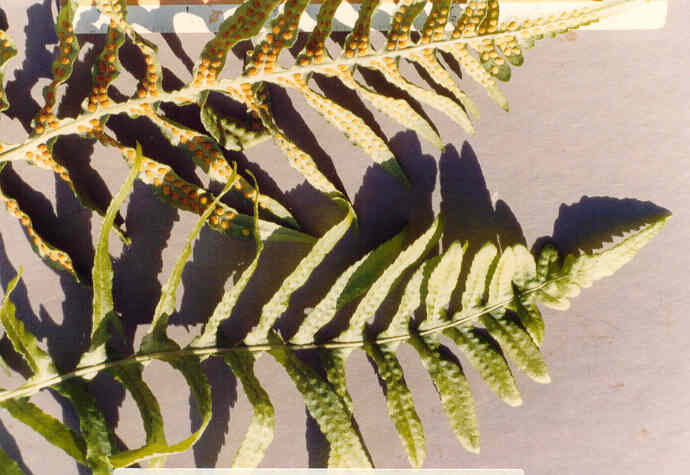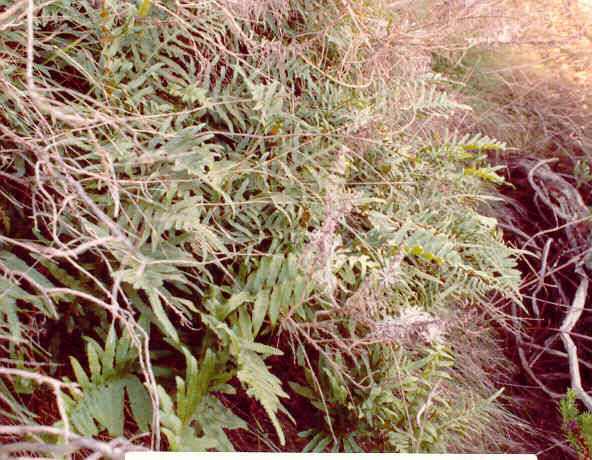
Polypodium californicum Kaulf.
 |
Polypodium californicum Kaulf.
Polypodiaceae (Fern Family)NativeCalifornia Polypody |
January Photo
Plant Characteristics:
Perennial with creeping rhizomes 5-10 mm. thick, with deciduous
deltoid-ovate rusty brown scales 3-7 mm. long; fronds not evergreen, 1-3.5 dm.
high; stipes stout, straw-colored, naked, mostly shorter than the blades; blades
oblong to narrow-ovate, pinnatifid nearly to the rachis, mostly 0.5- 3 dm. long,
0.5-1.5 dm. wide, the segms. membranous, linear-oblong, 3-7 cm. long, veins
mostly dark, opaque, 3-5 times forked, +/- casually joined and often forming an
irregular series of areoles; sori oval, slightly inframedial, lacking an
indusium, on inferior leaf surfaces.
Habitat:
Common winter and spring fern on rocky ledges and moist banks below 4000
ft.; Chaparral, Coastal Sage Scrub, etc.; cismontane s. Calif. n. through the
Coast Ranges and Sierra Nevada; Santa Barbara Ids.; L. Calif.
Name:
Latin, poly, many, and podium, foot. Many footed-referring
to the freely branching rhizomes or feet. (Bailey
78). Californicum, of Calif.; first found in this state.
(Dale 13).
General:
Occasional in the study area. Photographed
above Back Bay Dr. between the Newporter Inn and San Joaquin Hills Dr. and
between Big Canyon and the Salt Works dike.
(my comments). Delfina
Cuero, a Kumeyaay or Southern Diegueno Indian, made the following comments about
Polypodium californicum in her autobiography:
"Boil the roots and leaves to use for internal bleeding.
The name awi hatat means 'rattlesnake back'; that's what it looks
like." (Shipek 94).
P. vulgare, also a western plant,
has roots that have been
used as a pectoral, demulcent, purgative and anthelmintic.
A strong decoction is a good purgative and will expel tenia worms.
A dose of the powdered plant is from one to four drams. (one eighth of an
ounce). Of the decoction of syrup, from one to four fluid ounces, three or four
times a day. (Meyer 42).
As late as the 19th century ferns and other
non-flowering plants were called “cryptogams” because their reproduction was
hidden. There was lack of understanding about the nature of the “dust”
or fernseed that fell from the underside of fern leaves; was it a seed or
pollen? Today we know than fernseed is a spore, not a seed as it
contains no embryo. Spores germinate to form tiny, usually short-lived
plantlets that are different in appearance and function from the parent fern.
The plantlets develop male and or female organs, carrying sperm and eggs
respectively. Only after fertilization does the young fern, the sporling,
finally appear. (Machol, Guenther K. “FROM SPORE TO SPORLING: THE
BIRTH OF A FERN” FREMONTIA, A Journal of the California Native Plant
Society Vol. 32, No.2 April 2004 pp. 10-15).
About 75 species, mostly in N. Hemis.
(Munz, Flora So. Calif. 23).
Text Ref:
Abrams, Vol. I 8; Hickman, Ed. 100; Munz, Calif. Flora 45; Munz, Flora
So. Calif. 23.
Photo Ref:
Jan 1 84 # 16,17.
Identity: by R. De Ruff, confirmed by F. Roberts.
First Found: January 1984.
Computer Ref: Plant Data 262.
Have plant specimen.
Last edit 4/12/05.
 |
January Photo